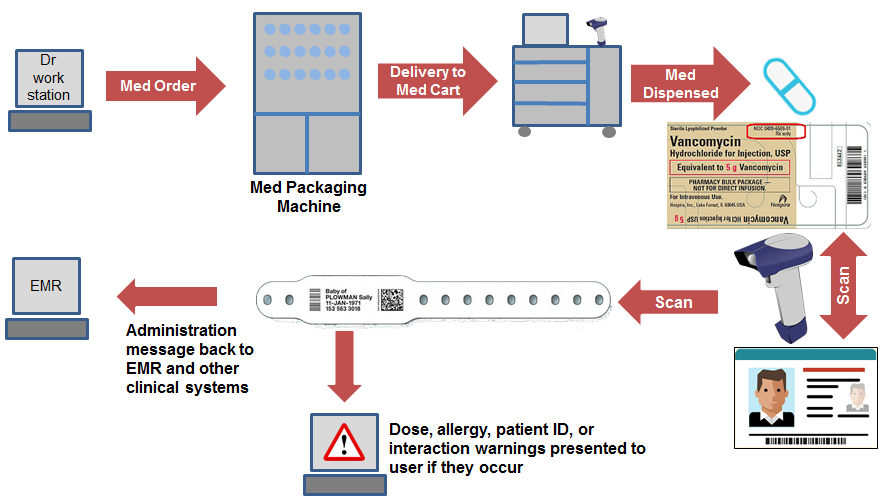In 1994, a nurse at Colmery-O’Neil Veterans Affairs Medical Center in Topeka, Kansas had an epiphany. She realized that the ubiquitous use of barcode scanning in other industries might be able to help with the administration of medications in a clinical setting. The backdrop for her idea was an alarming number of medical errors, estimated to cause between 44,000-98,000 deaths each year. The first pilot BCMA system was launched at a VA hospital in 1995. Thousands of other clinical settings have since adopted barcode medication administration.
The basics of barcode med administration involves the scanning of a barcode on the medication package, the patient armband, and the ID of the clinical staff giving the med. The collected data is cross-checked against a database of allergies, dose warnings, and interactions to prevent medication dose errors. At the heart of any medication administration is the “5 Rights”:
- The right patient
- The right drug
- The right dose
- The right route\The right time
Most medication errors occur at the point of the physician order or the administration of the med. Let’s have a look at a barcode administration workflow to see how this technology attempts to improve medication safety. This example is for a hospital setting with a central pharmacy:
- Physician places an order for a medication
- Medication order is transmitted electronically via an interface engine to a central pharmacy
- Pharmacy has an automated system that processes orders and performs the dose packaging of the meds that includes a barcode
- Medications are delivered to med carts on the hospital floors
- Nurse or other clinician dispenses the medication
- Enters their own ID verification (scanning badge in this case)
- Scans the medication
- Scans the patient’s armband
- If the patient is able to communicate, the nurse will also get a verbal confirmation of the patient’s identity
- Medication is given to the patient
At this point, the clinical system sends an interface message back to the electronic record that logs the medication order as ‘given’. Billing transactions will usually be created as well, but that’s not the focus of this article.

Does Barcode Medication Administration Work?
In my research, I did find some evidence that barcode medication administration reduced medication errors at some hospitals. The downside is that when we look at the national data, medication errors are still much higher than we would expect, considering the money that is being spent on the technology. There are other variables to consider, such as the steady increase of aging patients who need care, and the over-prescribing of medications. We could be trying to ‘prove a negative’ in the continuing analysis. In any case, here are some case studies:
Mary Lanning Memorial Hospital launched a barcode administration program in 2004, partially in response to a medication error that resulted in the death of a patient. At the conclusion of the implementation, the hospital realized an 88% reduction in medical errors. This hospital is just 157 beds, with an average daily census of 77, so while this study is encouraging, and lives were possibly saved; I don’t think this statistic could be applied universally. Source (pdf): Mary Lanning Barcode Med Study
Another study that might carry a bit more weight is from The Journal of Pediatrics. This 2008 study of a barcode medication administration system showed a 47% reduction of medication errors. Source: Journal of Pediatrics Barcode Medication Study.
As for the VA Pilot, I read one study that really surprised me. It did not report changes in medication errors, but looked for ways in which BCMA might introduce new problems in the workflows of the clinicians using it. One main side effect noted was a decreased coordination between nurses and doctors concerning the patients’ medication administration records (MAR). The technology seemed to hinder this coordination, at least in the beginning.
I expect there are some other factors in the VA hospitals that might contribute to this workflow issue. VA applications tend to not have very friendly user interfaces. Also, I have no idea how good their training and workflow analysis is. Source: VA Barcode Medication Administration Study.
Next Up:

Read More


